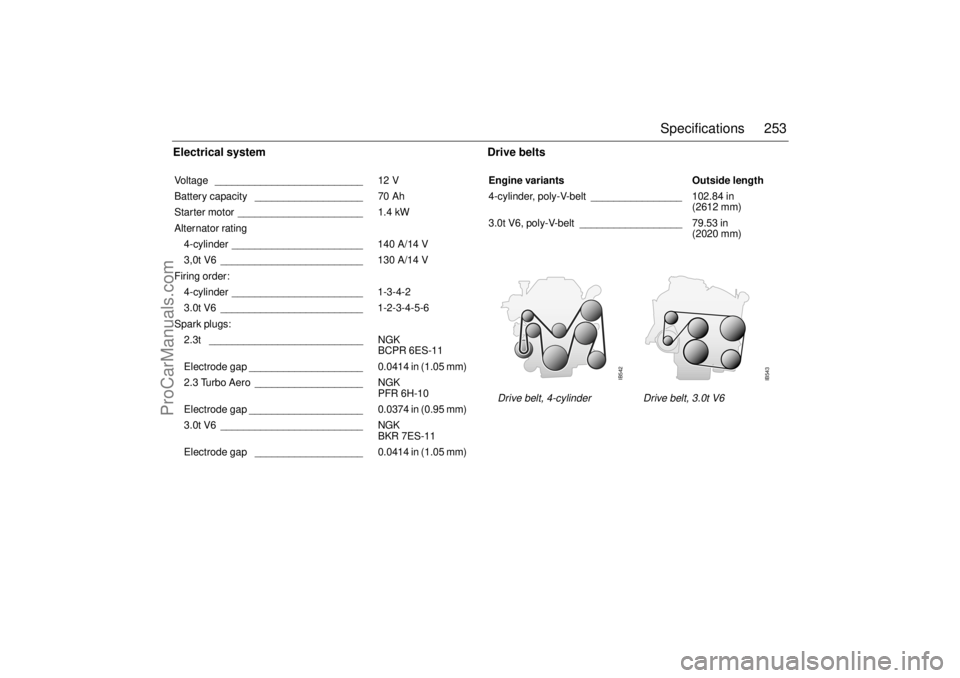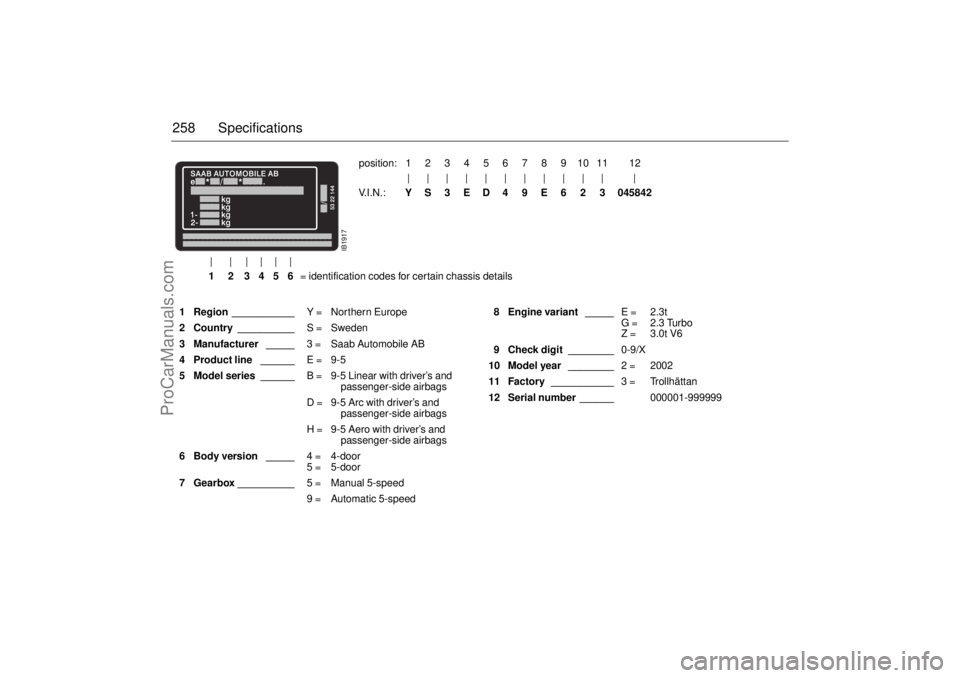SAAB 9-5 2002 Owners Manual
Manufacturer: SAAB, Model Year: 2002, Model line: 9-5, Model: SAAB 9-5 2002Pages: 272, PDF Size: 16.26 MB
Page 251 of 272

251 Specifications
Engine oilOil recommendation:
We recommend the use of oils that are available from your
Saab dealer, for regular oil changes. These oils fulfill the most
stringent requirements set by API and ACEA classifications.
Basic recommendations for Saab engines:
SAE 5W-30 or 0W-30, 5W-40.
The oil should be semi or fully synthetic and fulfill grade require-
ments for ACEA A3/B3, API SJ or higher. In addition to API and
ACEA the ILSAC GF-3 specification is approved for use in appli-
cable markets.
Fully synthetic oils with viscosity’s 0W-40/50 of well known
brands and fulfilling minimum ACEA A3/B3 are also recom-
mended, especially for extreme driving conditions.Oil specification.
Oil for gasoline engines is classified by the API (American Petro-
leum Institute) and ACEA (European Automobile Manufacturers
Associations) standards.
API classifies engine oil into grade classes SH (since 1993) and
SJ (since 1996). The SJ class fulfils more stringent requirements
and has lower phosphorous level. A new grade API SL, intro-
duced 2001, fulfils even higher requirements.
These grade classes are most often combined with correspond-
ing classes for diesel engines. The class designations for diesel
engines begins with the letter "C" (Commercial). For example a
grade combination suitable for both types of engine could be API
SH/CD, SJ/CF or SL/CF.
Under the ACEA nomenclature, oils are divided into Class A for
gasoline engines and Class B for diesel engine passenger cars.
There is a further class for heavy diesel engines. Each class is
divided into grades: 1,2 and 3 where grades 2 and 3 normally
encompass semi- and fully synthetic oils. The diesel class also
has a fourth grade, B4, which encompasses tests and regula-
tions aimed at improving the performance of direct injection die-
sel engines.
In the same way as in the API system, gasoline and diesel
engine specifications are combined for products that can be
used in both types of engine. For example, a grade designation
could be ACEA A2/B2 or ACEA A3/B3, B4.
ProCarManuals.com
Page 252 of 272

252 Specifications
Engine variants
Viscosity
:
The viscosity of oil is classified according to the SAE standard.
Nowadays, multigrade oils are always used in cars. The proper-
ties of these oils facilitate starting the car in cold weather but
mean that the oil is also viscous enough to coat al moving parts
under high pressures and with high outside air temperatures.
Multigrade oils are graded with two viscosity’s, e.g. 5W-30,
where 5W meets certain viscosity requirements at -4°F (-20°C),
while 30 fulfils requirements at 212°F (100°C).
Oil capacity incl. filter (on changing):
4-cylinder _______________________ 4.1 qts (4.0 litres)
3.0t V6 _________________________ 4.6 qts (4.5 litres)
2.3t Ecopower Rating, EEC at 5500 rpm ____________ 185 hp (136 kW)
Maximum torque, EEC at 1800 rpm ____ 207.2 ft.lb
(280 Nm)
Compression ratio _________________ 9.3:1 2.3 Turbo Ecopower (”Aero” model engine),
manual transmissionRating, EEC at 5500 rpm ____________ 250 hp (184 kW)
Maximum torque, EEC at 1900 rpm 259.0 ft.lb.
(350 Nm)
Compression ratio _________________ 9.3:12.3 Turbo Ecopower, (”Aero” model engine)
automatic transmissionRating, EEC at 5500 rpm ____________ 250 hp (184 kW)
Maximum torque, EEC at 1900 rpm 244.2 ft.lb.
(330 Nm)
Compression ratio _________________ 9.3:13.0t V6 Ecopower Rating, EEC at 5500 rpm ____________ 200 hp (147 kW)
Maximum torque, EEC at 2500 rpm ____ 229.4 ft.lb
(310 Nm)
Compression ratio _________________ 9.5:1
ProCarManuals.com
Page 253 of 272

253 Specifications
Electrical system Drive beltsVoltage __________________________ 12 V
Battery capacity ___________________ 70 Ah
Starter motor ______________________ 1.4 kW
Alternator rating
4-cylinder _______________________ 140 A/14 V
3,0t V6 _________________________ 130 A/14 V
Firing order:
4-cylinder _______________________ 1-3-4-2
3.0t V6 _________________________ 1-2-3-4-5-6
Spark plugs:
2.3t ___________________________ NGK
BCPR 6ES-11
Electrode gap ____________________ 0.0414 in (1.05 mm)
2.3 Turbo Aero ___________________ NGK
PFR 6H-10
Electrode gap ____________________ 0.0374 in (0.95 mm)
3.0t V6 _________________________ NGK
BKR 7ES-11
Electrode gap ___________________ 0.0414 in (1.05 mm)Engine variants Outside length
4-cylinder, poly-V-belt ________________ 102.84 in
(2612 mm)
3.0t V6, poly-V-belt __________________ 79.53 in
(2020 mm)
Drive belt, 4-cylinder Drive belt, 3.0t V6
IB542
IB543
ProCarManuals.com
Page 254 of 272

254 SpecificationsManual gearbox Automatic transmissionType ____________________________ All-synchromesh
5-speed with final
drive and differen-
tial
Oil ______________________________ Saab synthetic
manual gearbox oil
Oil capacity _______________________ 1.9 qts (1.8 litres)
Oil volume (on changing) ____________ 1.6 qts (1.5 litres)
Clutch type _______________________ Hydraulic, single
dry-plate clutch of
diaphragm-spring
type
Speed (mph / km/h) at 1000 rpm in 5th gear:
4-cylinder _______________________ 27–28 / 43–44Type _____________________________ Electronically con-
trolled 5-speed,
fully automatic with
hydraulic torque
converter, plane-
tary gear set and
integral final drive
Lock-up function in
selector positions 3,
4 and 5.
Selector-lever positions ______________ P R N D 4 3 L
Transmission-fluid capacity, dry transmis-
sion (incl. torque converter and oil cooler) 7.5 qts (7 litres)
If fluid change required, approximately
3.5 litres can be drained through the drain
plug in the transmission casing
Transmission fluid ___________________ Saab 3309 (mineral
oil based)
Clutch type ________________________ Hydraulic plate
clutches, brake
bands and one-way
couplings
Speed (mph / km/h) at 1000 rpm in 5th gear:
4- cylinder engines and 3.0t V6 _______ 29 / 47–48
ProCarManuals.com
Page 255 of 272

255 Specifications
Suspension
SteeringBrake systemSpring type, front and rear ___________ Coil springs
Maximum deflection of springs:
Front __________________________ 7.09 in (180 mm)
Rear ___________________________ 7.87 in (200 mm)
Dampers, front and rear _____________ Gas-filled dampers
Steering _________________________ Power-assisted
steering of
rack-and-pinion
type; telescopic
steering-column
shaft with universal
joints
Number of turns, lock to lock __________ 2,9
Power-steering fluid ________________ Power-steering
fluid CHF 11S Footbrake (ABS) ____________________ Hydraulic disc
brakes with vacuum
servo unit. Diago-
nally split circuits;
ventilated discs on
front wheels. EBD
function, see page
165.
Handbrake ________________________ Acts on rear wheels
Brake fluid _________________________ DOT 4
Brake-fluid capacity _________________ 0.925 qts (900 ml)
Disc diameter:
Front ___________________________ 11.34 in (288 mm)
Front, certain variants *) _____________ 12.05 in (306 mm)
Rear ___________________________ 11.26 in (286 mm)
Rear, certain variants *) _____________ 11.81 in (300 mm)
*) 15” wheel must not be used on these
variants.
Total friction area of brake pads:
Front ___________________________ 36.3 in
2 (234 cm
2)
Rear ___________________________ 15.5 in
2 (100 cm
2)
ProCarManuals.com
Page 256 of 272

256 SpecificationsWheels and tiresWheel size _______________________ 6.5 x 16 or 7 x 17
2.3 Turbo Aero _____________________ Use only 6.5 x 16 or
7 x 17 only
Contact an authorized Saab dealer if you
wish to fit other wheels than those fitted
as standard.
Tire size (summer tires):
6.5 x 16 wheels __________________ 215/55 R16
7 x 17 wheels ____________________ 225/45 R17
Tire size (winter tires):
6 x 15 wheels (Linear only: not 2.3 Turbo
Aero or 3.0 V6) ___________________ 195/65 R15 M+S
6.5 x 16 wheels___________________ 205/55 R16 M+S
Recommended wheels for snow chains 6 x 15 (not 9-5 2.3
Turbo Aero) or
6.5 x 16
Compact spare:
Wheel __________________________ 4 x 16
Tire ____________________________ T115/70 R16
Pressure ________________________ 60 psi (420 kPa)
Maximum life ____________________ 2,200 miles
(3500 km)
Maximum speed _________________ 50 mph (80 km/h)
NOTESnow chains:
Snow chains must not be fitted to the rear wheels, and may only
be used with the following wheel-tire combinations:
Wheels Tires
6.5 x 15_____195/65 R15 M+S
(Linear only: not 2.3 Turbo Aero or 3.0L V6)
205/65 R15
(Linear only: not 2.3 Turbo Aero or 3.0L V6)
6.5 x 16_____205/55 R16 M+S or
215/55 R16
Snow chains must not be fitted to 17" wheels.
Max. permissible speed with snow chains fitted is 30 mph
(50 km/h).
Contact an authorized Saab dealer for advice on snow chains.NOTEWheels larger than 17” must not be fitted.
The wheel offset must not exceed 49 mm.
Vehicles with 12.05 in (306 mm) front brake discs must not use
15” rims.
ProCarManuals.com
Page 257 of 272

257 Specifications
Plates and labels When consulting your Saab dealer, it may be
necessary to quote the car’s V.I.N., engine
and gearbox numbers.
1 Modification identity plate.
2 V.I.N. number, inside windshield.
3 Certification label.
4 Gearbox number.
5 Engine number.
6 Tire pressures and color codes
(body & trim), label.
7 Chassis number plate.
8 Chassis number, stamped on body.
9 Vehicle Emission Control Information.
IB1948
CANADA US
ProCarManuals.com
Page 258 of 272

258 Specifications 1 Region ___________Y = Northern Europe
2 Country __________S = Sweden
3 Manufacturer _____3 = Saab Automobile AB
4 Product line ______E = 9-5
5 Model series ______B = 9-5 Linear with driver’s and
passenger-side airbags
D = 9-5 Arc with driver’s and
passenger-side airbags
H = 9-5 Aero with driver’s and
passenger-side airbags
6 Body version _____4 =
5 =4-door
5-door
7 Gearbox __________5 = Manual 5-speed
9 = Automatic 5-speed8 Engine variant _____E =
G =
Z =2.3t
2.3 Turbo
3.0t V6
9 Check digit ________0-9/X
10 Model year ________2 = 2002
11 Factory ___________3 = Trollhättan
12 Serial number ______000001-999999 position:1234567891011 12
||||||||||| |
V.I.N.:YS3ED4 9E62 3045842
| | ||||
1 2 3456= identification codes for certain chassis details
IB1917
ProCarManuals.com
Page 259 of 272

259 Specifications
Several of the systems in your Saab
car can be adjusted to better fit your
individual needsSome functions are governed by legal
requirements and cannot therefore be
reprogrammed.
Consult an authorized Saab dealer for fur-
ther information.
Car alarm/central locking system:
The sound level of the siren when locking/
unlocking, HIGH or LOW.
The number of blinks when locking/
unlocking, 1 to 7.
Automatic locking of the trunk when the
car is driven, 1 to 8 mph (2-14 km/h), YES
or NO.
Preclude the unlocking of the trunk while
the car is driven, YES or NO.
Automatic locking of the trunk after
1 second-4 minutes if it has not been
opened, YES or NO.
Automatic locking of the trunk when it is
closed, YES or NO.
Automatic locking of all doors when the
car is driven above 7.5 mph (12 km/h),
YES or NO.Saab Information Display:
Outdoor temperature display can be
adjusted.
Miscellaneous:
Select the on-time for heated rear seat.
Coolant temperature gauge adjustment
can be increased/decreased.
Fuel level gauge adjustment can be
increased/decreased.
Additional sweep of the wipers after wind-
shield washer function (ON or OFF).
Follow me home on-time can vary from 20
to 50 seconds.
Night panel illumination deactivation
speed for the speedometer can be
adjusted.
Following adjustments can be done
by the driver:Automatic Climate Control (ACC):
To alter the preprogrammed ”AUTO” start
up mode with your own preferences you can
manually select the desired settings for:
Temperature.
Fan speed.
Air distribution.
See ”Programming I” on page 78 and ”Pro-
gramming II” on page 79.
Saab 9-5 Audio System (see page 99):
Maximum starting volume (when the
radio is switched on).
Telephone volume (if the car is equipped
with a phone connected to the audio sys-
tem).
Speed dependent volume (volume
increases or decreases with vehicle
speed).
Loudness.
Alarm system:
The glass breakage sensor can be tempo-
rarily disabled, see page 44.
Daytime Running Lights:
To disable, turn off the ignition and pull out
fuse 35, see page 218.
ProCarManuals.com
Page 260 of 272

260 Specifications(This page has been left blank)
ProCarManuals.com